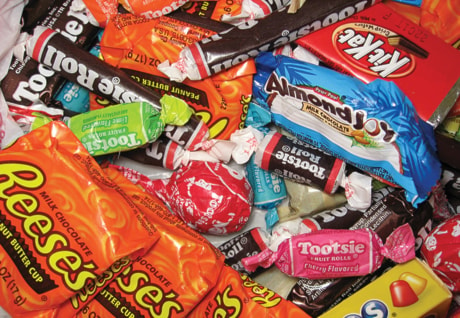This time of year, we’re accustomed to thinking that candy is the way to someone’s heart.
But what if candy were also the way to your muscles? Your T-cells? Your liver? Your lungs?
In short, what if candy were as good for you as it is good-tasting?
Some ingredients in candy may be healthful, but does that make the candy beneficial?
Of course, candy companies don’t market their products as substitutes for healthful meals. But we figured there must be some nutritional value to them. We took a quick look at some of the nutritional ingredients and some of the information about those that appears online.
Then we asked nutrition expert and University of California, Davis, professor Judith Stern what she thought.
The bottom line: “Caveat emptor,” Stern said. Buyer beware.
Think about calories, think about fat, think about sugar. Do research on a reputable nutrition site like the National Institutes of Health’s National Center for Complementary and Alternative Medicine, nccam.nih.gov.
“You have to know what you’re getting,” Stern said.
Here’s what we found about some of our favorite candy.
ALMOND JOY
• Chocolate-covered coconut and almonds, 1.61 ounces, 220 calories.
Nutritional content: Coconut and almonds.
Why that might be good: Sounds like a good source of dietary fiber.
Looking at the calories, Stern noted, “It’s better than some of the bigger bars.”
What about the fiber? It’s two grams, or eight per cent of the daily value for a 2,000-calorie diet. “We don’t get enough fiber,” she said, “(but) it wouldn’t be your first choice.”
In other words, pick something that doesn’t have sugar (or corn syrup in this case) as the main ingredient.
YOUNG & SMYLIE LICORICE
• Old-fashioned soft black licorice pieces, 8 ounces, 1,540 calories or 140 per 11-piece serving.
Nutritional contents: Licorice root extract.
Why that might be good: Licorice may help with peptic ulcers, HIV infections, skin problems, hepatitis, PMS and more, according to www.nutritional-supplements-health-guide.com.
Notably, a fact- and lore-filled website for the manufacturer makes no claims beyond ancient beliefs.
Stern looked at the NCCAM website, where it says there have been clinical trials on hepatitis but that claim, and one regarding peptic ulcers, don’t have enough evidence.
On the other hand, there are side effects and warnings, especially for pregnant women and people with high blood pressure.
Even if licorice root is beneficial, “I don’t know that 11 pieces (per serving) would be enough,” said Stern.
3 MUSKETEERS
• Chocolate bar with whipped center, 2.13 ounces, 260 calories.
Nutritional contents: Label says prominently, “45 percent less fat.”
Why that might be good: Fat is a big source of calories, which many people consume in excess.
“The problem is the serving size.” That amount of calories is more than an eighth of the daily allocation for an average woman. And even with “less fat,” the bar’s calories are more than a quarter from fat.
DARK CHOCOLATE RAISINETS
• Chocolate-covered raisins, 3.5 ounces, 360 calories
Nutritional contents: Label prominently says, “Natural source of fruit antioxidants.”
Why that might be good: Both chocolate and the raisins have antioxidants, which are said to aid in slowing down age and disease processes.
“Antioxidants are fine. You usually don’t get much from chocolate.”
Stern’s favored source is dark chocolate Dove hearts. “What I care about with chocolate, please, is taste.”
But she rations her intake.
“The whole thing is: Don’t take too many calories.” Stern pointed out that the Raisinets box says 180 calories per serving, with two servings per box. Who eats only a half box?
SNICKERS
• Chocolate bar with peanuts and caramel, 2.07 ounces, 280 calories
Nutritional contents: Peanuts.
Why that might be good: Peanuts contain protein, which muscles need.
“Peanuts can be a problem,” Stern said, referring to peanut allergies. “Most people get plenty of protein.”
Aside from that, we’re talking about even more calories than in the 3 Musketeers. “You’re not eating it for nutrition. You’re eating it for the taste.”
STARBURST
• Tropical fruit chews, 2.07 ounces, 240 calories
Nutritional contents: 50 per cent of your daily value of Vitamin C.
Why that might be good: Vitamin C is needed for healthy bones and teeth. It aids absorption of iron. It’s widely believed to fight colds.
“Mostly what you get from Starburst is sugar.” The first two ingredients (indicating the most plentiful ingredients) are corn syrup and sugar.
“It’s like adding Vitamin C to Pepsi.”
As for its benefit with colds: “It may decrease very, very slightly the duration of the cold.”
Distributed by Scripps Howard News Service
